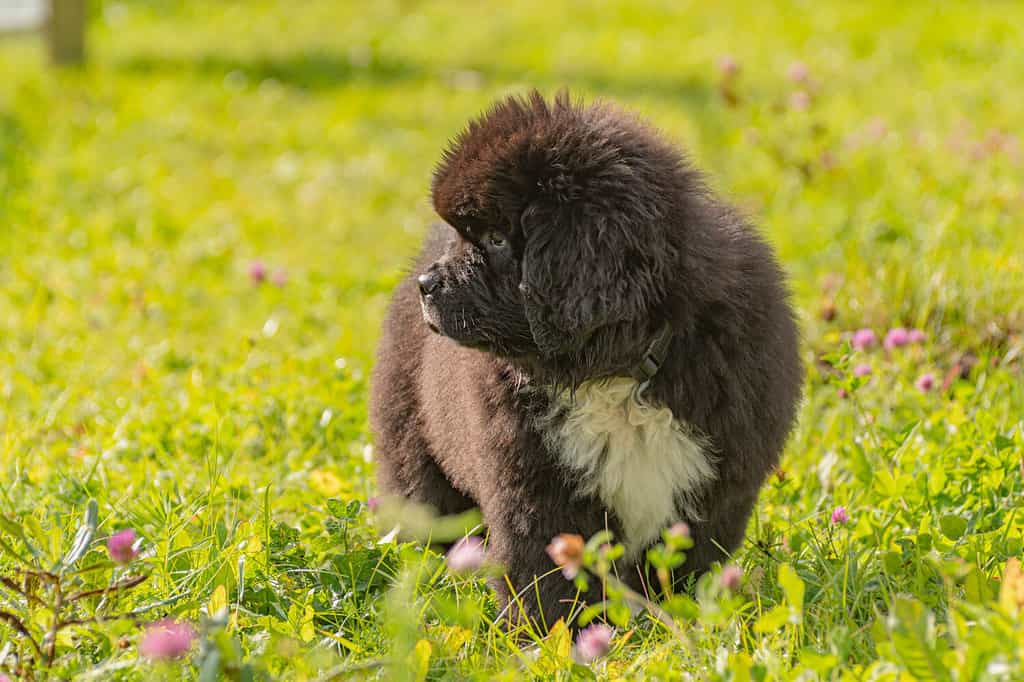The Newfoundland, also sometimes called the “Newfie,” makes an excellent addition to nearly any household. Their sharp intelligence, unwavering loyalty, and affectionate personalities are all hallmarks of the breed. They’re just as popular today as they were when first developed, and it’s easy to see why! Today, we explore the history of this breed and share some tips that will make the process of purchasing a Newfoundland puppy much easier.
An Introduction to the Newfoundland Breed

On average, Newfoundland dogs live for about eight to 10 years.
©DejaVu Designs/ via Getty Images
In terms of appearance, the Newfoundland is a large-sized dog with a strong, sturdy body. At maturity, this breed will weigh between 100 and 150 pounds, depending on the gender. Newfies have a flat double coat, and the most popular colorations are black, brown, grey, and white. Although they don’t have extremely high grooming needs, routine bathing and brushing must be done in order to prevent matting of the fur. Those with allergies may have some trouble with this breed as they are prone to shedding. In addition, those who consider themselves “neat freaks” would do best to consider another breed as well. Although this dog has many attractive qualities, drool, fur, and messes are sure to follow wherever they may go.
However, according to the American Kennel Club, the single most important characteristic of this breed is its sweet disposition. Despite their large size, they’re complete mush balls. This breed truly embodies the title of “gentle giant.” Because of this, this breed is excellent for both first-time and experienced dog owners. Their relaxed attitude, unwavering patience, and affectionate personalities make them perfect family dogs, and they mesh well in homes with young children or other animals.
History of the Newfoundland Dog

Newfoundlands have a need for attention. Owners who spend hours away should reconsider this breed.
©LigaP/Shutterstock.com
Originally bred to be working dogs, the Newfoundland is a giant breed of high intelligence. Although the exact story of how this breed originally developed is murky, it is generally agreed upon that the Newfie was derived from Pyrenees sheepdogs that were brought to Newfoundland by French fishermen between the 1500s and the 1600s. These dogs were then bred with retrievers brought over by English colonists, and so began the Newfoundland breed. According to the Newfoundland Club of America, “Their instinct for water and retrieving gives the breed an immense advantage over all other canines. It is this that makes them logically the dog for the long waterfront of sea, river, and lake of North America.”
The Importance of Finding a Reputable Newfoundland Breeder

Newfies love to swim and spend time playing by the water.
©ABphotopro/Shutterstock.com
As with any dog, the most important step in the process of bringing one home is to find an ethical, reputable breeder. The average price range for a Newfoundland puppy is between $1,000 and $2,500. However, prices can climb even higher than this range for certain pedigrees or specialized training. Be very cautious if you find people advertising Newfoundland puppies for well below this threshold. Often, this is a warning sign that the breeder hasn’t performed genetic testing on their animals. Because of this, congenital disease runs rampant, and owners are at risk of bringing home a very sick animal. Severity can range from lifelong discomfort to premature death. Owners can spend years watching their Newfie suffer and spending thousands of dollars at the vet, or in the worst cases, they can lose their dog altogether.
Buying from ethical breeders with strong reputations eliminates this risk almost entirely. Although you’ll pay more upfront, you’ll also have peace of mind that you’re bringing home a healthy animal. In fact, many ethical breeders are so confident in the quality of their animals that they offer a health guarantee on their puppies. This is a certain grace period, typically three years or so, where the buyer is covered monetarily in the event their animal receives a diagnosis covered by the agreement. In these cases, the buyer becomes eligible for a refund or replacement.
Growth and Milestones

During their first year of life, Newfoundland puppies will undergo an amazing growth spurt.
©cynoclub/Shutterstock.com
Many owners will bring their Newfie home when they are about eight weeks old. At this time, a puppy will weigh somewhere between 15 and 25 pounds, depending on their gender. At this size, puppies should be eating about 3/4 to one cup of food per day, split up into three different meals. As a general rule, owners can feed their Newfie puppy about one cup of food per 25 pounds of weight they gain. After your dog grows to be about six months old, you can transition these portions from three meals a day to two meals a day. Newfoundlands will typically stop growing around 12 months of age, but development can continue until they reach two years old.
Since this breed is as sharp as a tack, owners may begin training them soon after they bring them home. At this time, their brains are like sponges, and they are eager to absorb as much information as possible. Start with simple commands like sit, stay, or lay down to get them into the swing of things before moving on to more complex ones. As the Newfoundland is a larger breed, owners may want to wait until their puppy is a bit older before spaying or neutering to allow time for them to grow. Talk to your vet for more information about your dog’s specific needs.
How to Prepare

Many people state that Newfoundlands make excellent service animals.
©JStaley401/ via Getty Images
Since Newfoundlands are such large dogs, it’s important to be sure you have the proper space to accommodate them as they grow. These dogs are not well suited for cramped spaces such as apartments. In addition, Newfoundlands require about 30 minutes of exercise per day. This can be met by taking walks, playing with toys, or letting them run around the backyard. Make sure you’re able to set aside time in your schedule to meet their activity needs.
If this is the first dog in your home, you’ll want to put aside about $400 for food and supplies. It’s also best to reserve about $200 for medical expenses, such as an initial health screening, vaccinations, and microchipping. Newfoundlands are a lovable breed with many wonderful qualities. However, they might pose a challenge to first-time dog owners or those who are used to smaller animals. Despite this, many people say that they’re worth the extra effort. This breed is beloved by many, and it’s very easy to see why.
The photo featured at the top of this post is © DejaVu Designs/ via Getty Images
Ready to discover the top 10 cutest dog breeds in the entire world?
How about the fastest dogs, the largest dogs and those that are -- quite frankly -- just the kindest dogs on the planet? Each day, AZ Animals sends out lists just like this to our thousands of email subscribers. And the best part? It's FREE. Join today by entering your email below.
Thank you for reading! Have some feedback for us? Contact the AZ Animals editorial team.






